Configuration¶
In the measurement mode the UI is not enabled and the device will go into deep sleep once the sensors has
been read and data has been transmitted.
The device can operate in modes and must be in configuration mode in order for the web
server to be active. The device (esp) LED will flash slowly or show blue color when the device
is in configuration mode.
If the LED is constant or show white color then the device is in wifi setup mode where access is done through
the Access Point provided by the software. It can also be triggered when pressing the reset button multiple times.
This mode is only used for configuring the wifi settings since sensors are not active in this mode. It can also
be used as a failsafe mode if the sensors cause startup issues.
One of the following conditions will place the device in configuration mode:
Gyro has not been calibrated (Only applies to the MPU6050/MPU6500)
Configuration mode has been forced in the web user interface on main page.
The TX/RX pins are connected which will force the device into configuration mode.
Placed in horizontal mode 85-90 degrees on gyro
Battery shows >4.15V or the value that is configured
Battery shows below 2V
Tip
The easiest way to enter configuration mode is to place the device on a flat surface and press the reset button once.
From v2.3 i have added a reporting feature to collect information on what targets are being used for this project. It will report data anonymously and no personal data is collected. The data being sent is shown in the table below.
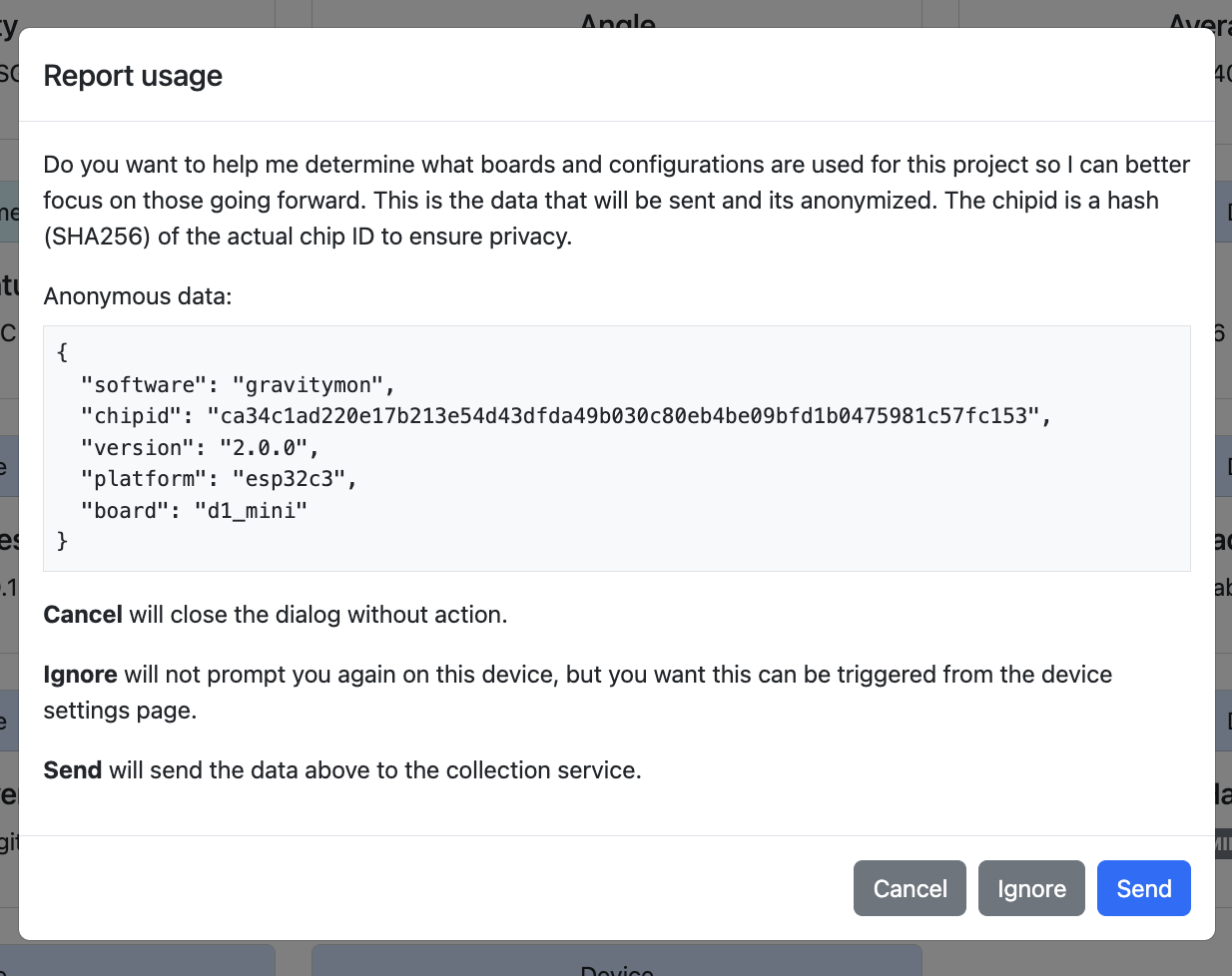
There is also a data collection feature related to the calibration and formula creations to see if that can be improved futher.
Home page¶
URL: (http://gravmon.local)
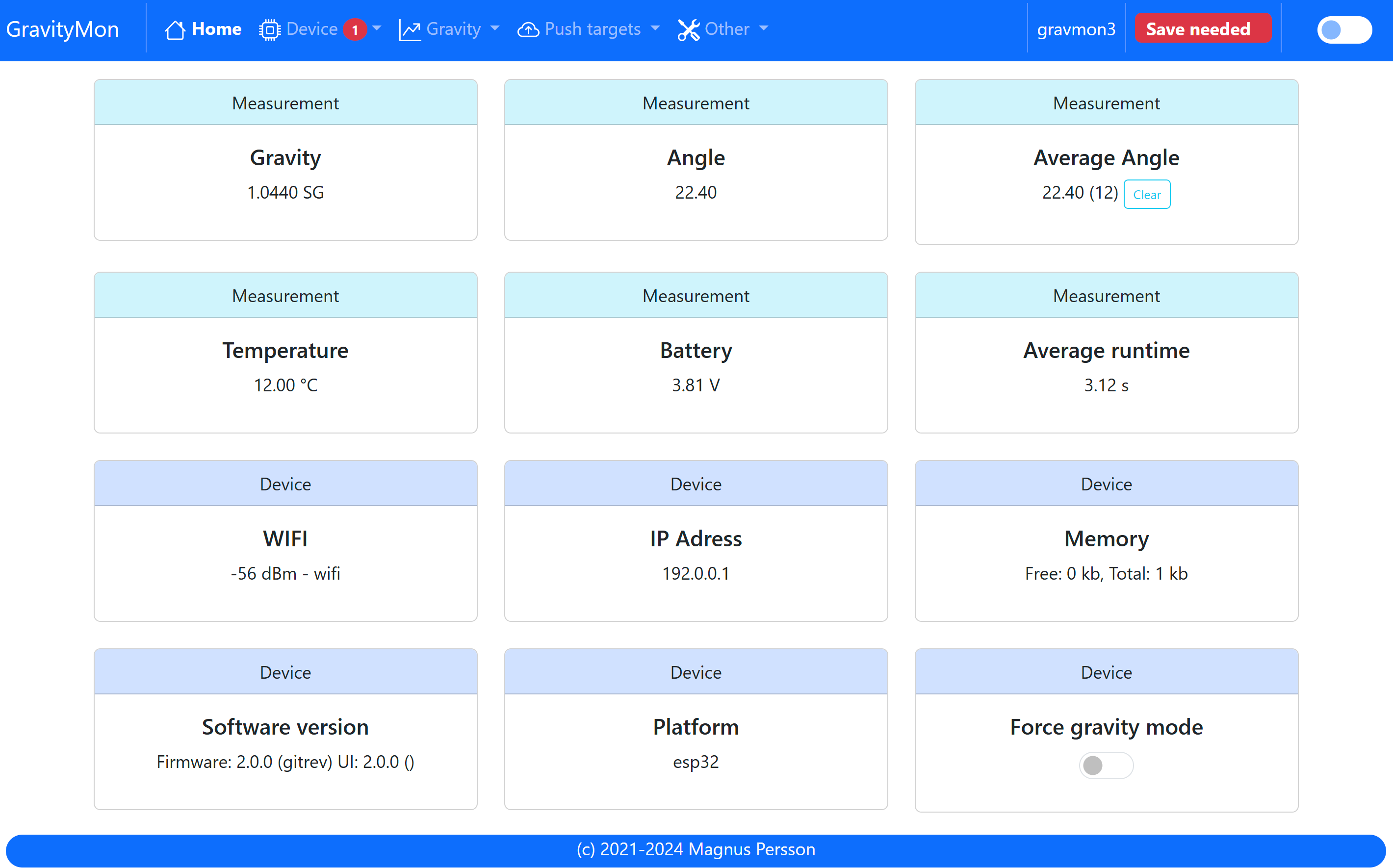
Configuration is accessed by entering the URL for the device, this will be the mDNS name device.local or the IP address. The following chapter assumes the device name is gravmon.
If the device is not fully configured or there are some hardware issues then these will be visible on the main page. If there are things to adress this will be indicated in the meny using a red dot.
The main page shows the device readings; gravity, angle, temperature and battery charge. If the checkbox is active then the device will never go into sleep mode. This is useful if you are collecting angle/tilt for calibration. If this is unchecked the device will change mode as explained before.
You can also view the average time a gravity measurement takes. Under optimal setting this should be around 1.5 - 2.0 seconds. If this is higher than 2 seconds this is most likely connected to slow wifi connection. It will show 0 if data has not been collected yet.
Tip
If you are connected to the device via a serial console (speed: 115200) you can see the connection sequence and get the Unique ID and IP address from there.
Device¶
Device - Settings¶
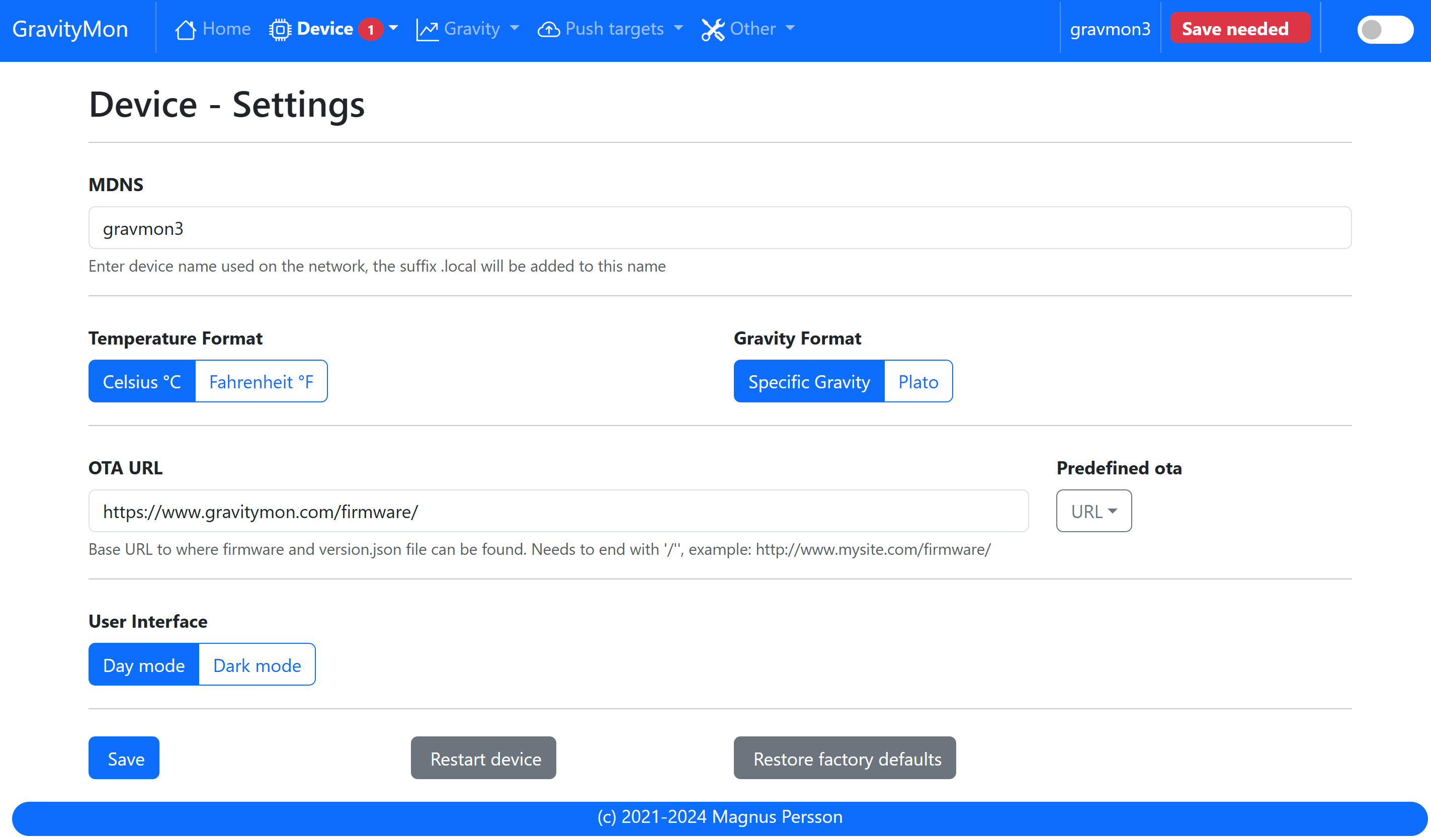
MDNS:
This is unique name for the device. It will be used in pushing data as well as mDNS name on the network (<name>.local). The limitation is 63 chars but using long names might break endpoints that data is sent to if they have other limitations.
Temperature format:
Choose between Celsius and Fahrenheit when displaying temperature.
Gravity format:
Gravity format can be either SG or Plato. The device will use SG Internally and convert to Plato when displaying or sending data.
OTA URL:
Should point to a URL where the firmware.bin file + version.json file are located. For an ESP32 target the firmware should be named firmware32.bin.
For the OTA to work, place the following files (version.json + firmware.bin) at the location that you pointed out in OTA URL. If the version number in the json file is newer than in the code the update will be done during startup.
If you have the previx https:// then the device will use secure transfer without CA validation.
Example; OTA URL (don’t forget trailing dash), the name of the file should be firmware.bin
http://192.168.1.1/firmware/gravmon/ https://192.168.1.1/firmware/gravmon/
User Interface:
Switches the UI between light and dark mode. You can also use the toggle on the menubar for that.
Check status
Checks if this device has been reported to the data collection service.
Factory default
This function will reset all settings to factory default. Use with caution!
Restart
Restarts the device, similar to pressing the reset button
Report Usage
Opens a dialog and allows the user to see the data beeing sent and confirm sending it to the data collection service.
Device - Hardware¶
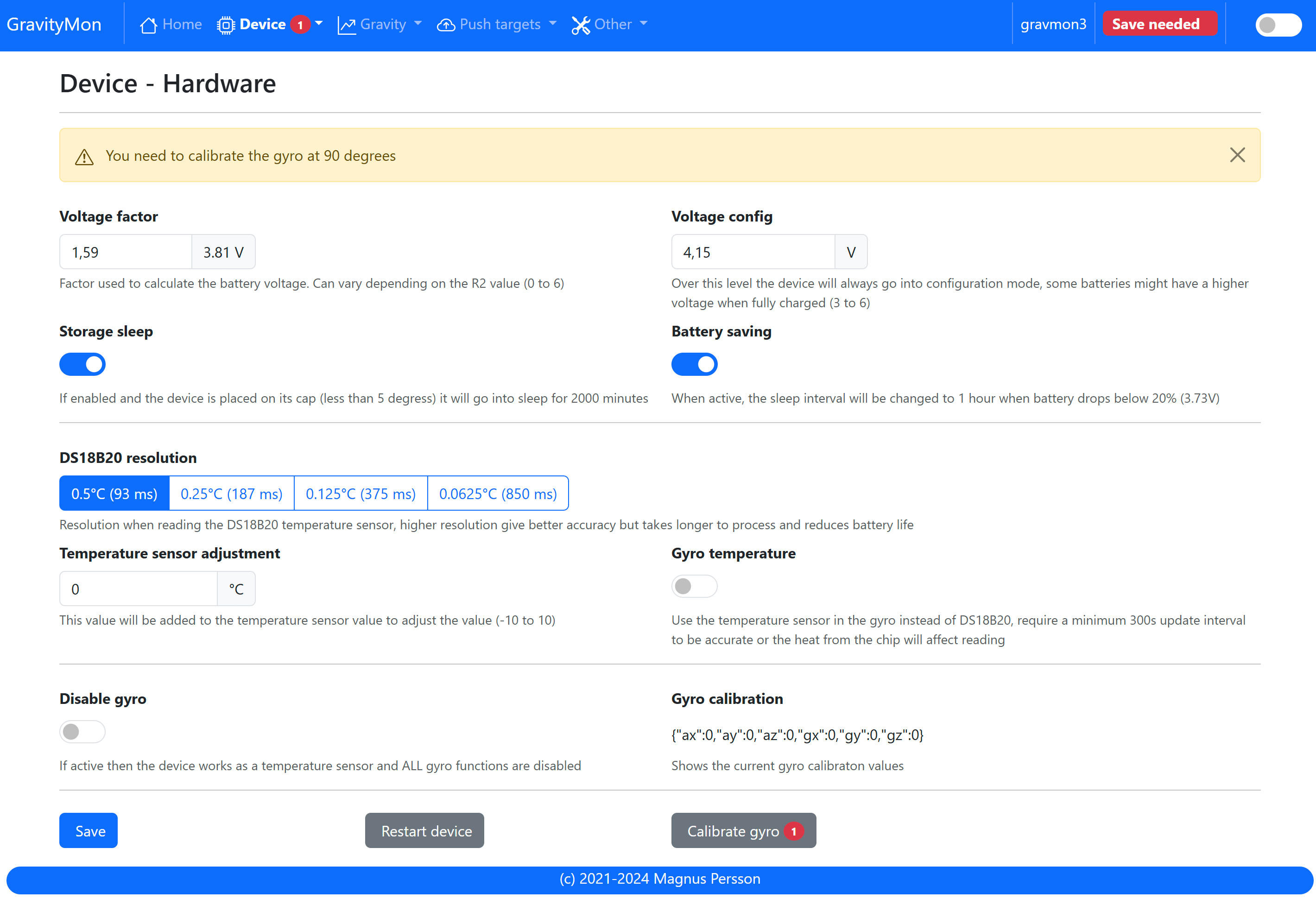
Voltage factor:
Factor used to calculate the battery voltage. If you get a too low/high voltage you can adjust this value.
Config voltage:
Defines the level of voltage when the device should enter config mode due to charging. This might vary between different battery manufacturers. If you don’t what the device to go into configuration mode when charging, set this to 6V. This was added since different batteries have different voltages when fully charged.
Storage sleep
When place on the cap (<5 degree tilt) the device will go into deep sleep forever (until reset). In order to wake it up you need to do a reset. One option is to attach a magnetic reed switch (default open) to the reset pin and use a magnet to force a reset without opening the tube. The reed switch is typically an electronic component of 14 mm long encapsulated in a small glass tube. See hardware section for more information, Hardware.
Charging PIN ESP32
When enabled and power is applied to the charging pin the device will go into deep sleep, this requires the Gravitymon PCB with this feature enabled. This is useful when charging the device via a wireless charger so the device is in deep sleep and when removed from the charger it wakes up. This is an improved variant of the Storage sleep feature.
Battery saving:
If this option is checked the sleep interval will be changed to 1 hour when battery drops below 20%. Default = on.
DS18B20 Resolution:
Define the resolution used on the temp sensor. 9 bits is default and will give an accuracy of 0.5C and and provide longest batterylife. See data below from the datasheet.
9 bits = 0.5°C, up to 93 ms reading
10 bits =0.25°C, up to 187 ms reading
11 bits = 0.125°C, up to 375 ms reading
12 bits = 0.0625°C, up to 850 ms reading
Temperature sensor adjustment:
This value will be added to the temperature reading (negative value will reduce temperature reading). This is applied when the device starts. So changing this will not take affect until the device is restarted.
Gyro Temperature:
Enable this feature will use the temp sensor i the gyro instead of the DS18B20, the benefit is shorter run time and longer battery life (this is an experimental feature). The value used is the first temperature reading from when the device is activated, since the gyro should be cool this is reflecting the surrounding temperature. After it has been running the value would be totally off.
Device - Gyro¶
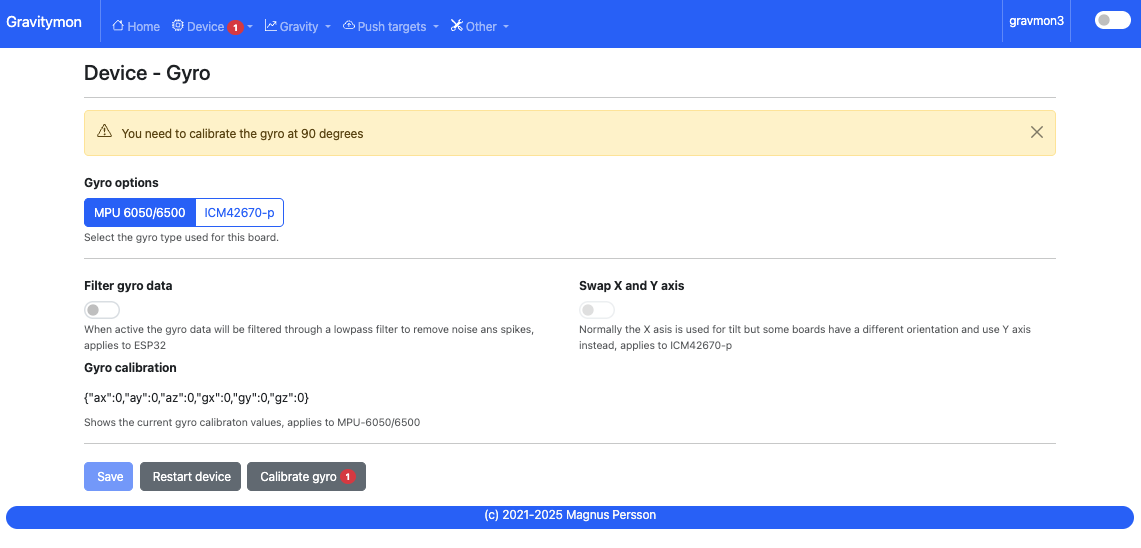
When performing gyro calibration the device will now show an error if the calibration takes longer than 15 seconds for accelerometer or 15 seconds for the gyro.
Gyro options:
Select the gyro that is used in the device
Low pass filter: ESP32
When enabled the gravity data will be sent through a low pass filter to reduce noise and peaks in the signal.
Swap X and Y axis:
When enabled this option will use the Y axis for the tilt calculation instead of the X axis. The ICM development boards uses this orientation.
Calibration values:
These are calibration data for the gyro. Place the device flat on a table and press the button to save the default orientation values. Without this calibration we cannot calculate the correct angle/tilt.
Device - WIFI¶
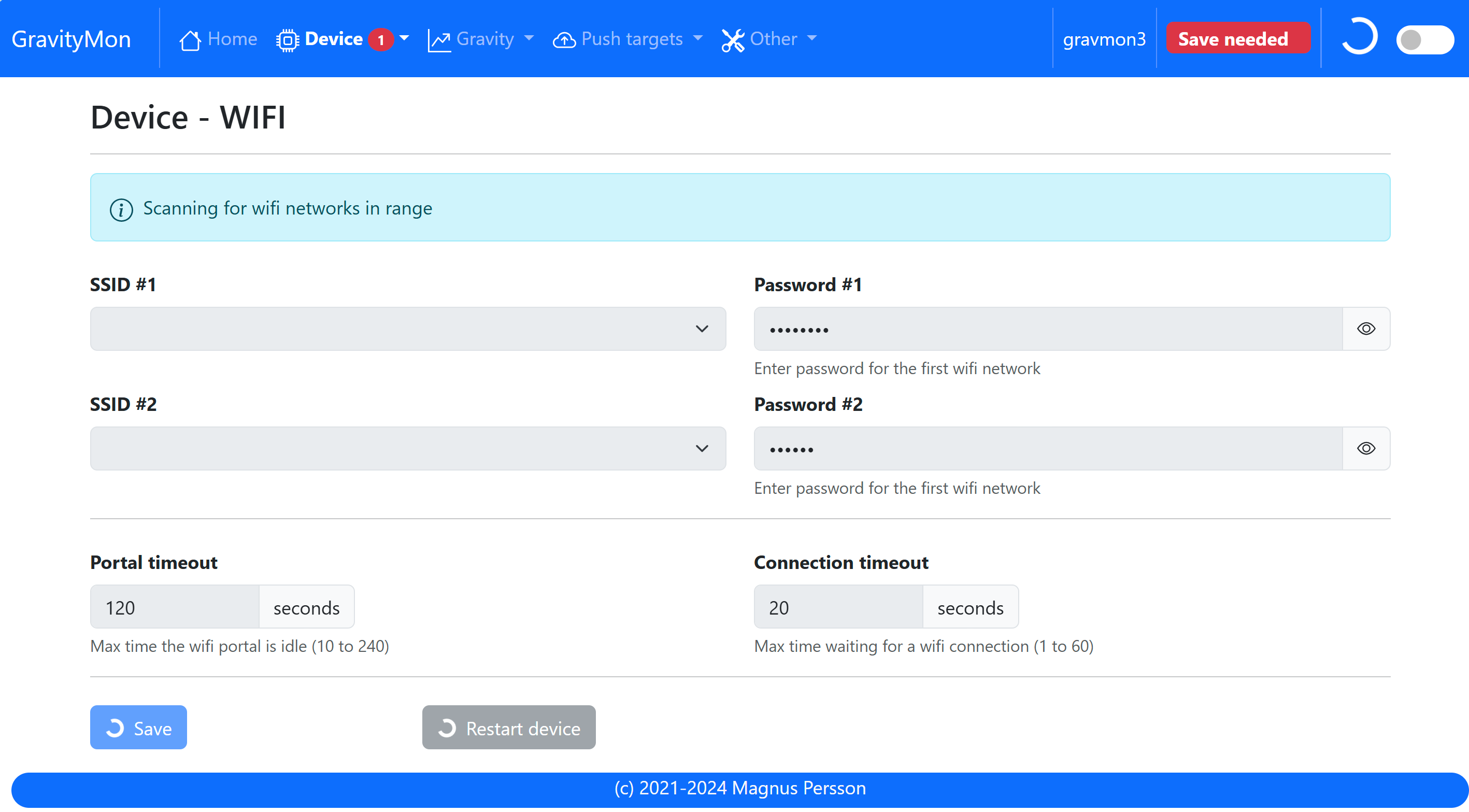
If you have hidden SSID for your network then use the webflasher to configure the wifi.
SSID #1:
Select the desired primary SSID to use.
Password #1:
Enter the primary password.
SSID #2:
Select the desired secondary SSID to use (optional).
Password #2:
Enter the secondary password (optional).
Portal timeout:
If the wifi portal is triggered (can be triggered by tapping the reset button 2-3 times within 3 seconds) then this is the amount of time allowed before it exists again.
Connect timeout:
This is the amount of time allowed for a wifi connect.
Scan for strongest AP:
When enabled the device will always scan for the strongest access point transmitting the configured SSID. This will drain power faster so use with caution.
Gravity¶
Gravity - Settings¶
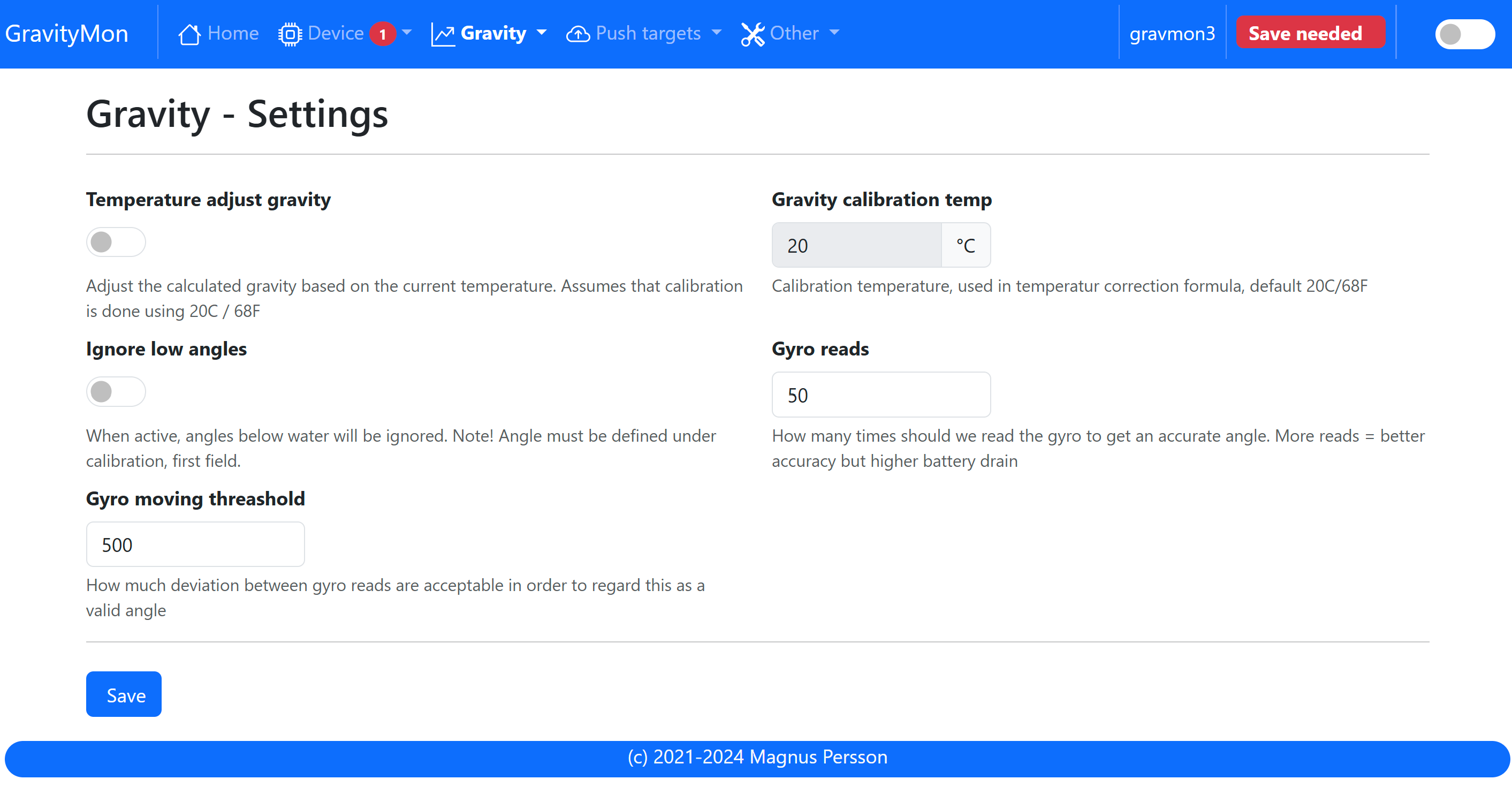
Temperature adjust gravity:
Will apply a temperature calibration formula to the gravity as a second step after gravity has been calculated. It’s also possible to build this into the gravity formula.
Tip
This formula assumes that the calibration has been done at 20°C / 68°F.
Formula used in temperature correction. The calibration temperature can be changed under advanced settings.
gravity*((1.00130346-0.000134722124*temp+0.00000204052596*temp^2-0.00000000232820948*temp^3)/ (1.00130346-0.000134722124*cal+0.00000204052596*cal^2-0.00000000232820948*cal^3))
Gravity calibration temp
This option allows you to set the correction temperature used in the automatic temperature gravity adjustment formula. Standard is 20C.
Ignore low angles:
If this option is checked any angles below that of SG 1 will be discarded as invalid and never sent to any server. Default = off.
Gyro reads:
This defines how many gyro reads will be done before an angle is calculated. More reads will give better accuracy and also allow detection of movement. Too many reads will take time and affect battery life. 50 takes about 800 ms to execute.
Gyro moving threshold:
This is the max amount of deviation allowed for a stable reading.
Gravity - Formula¶
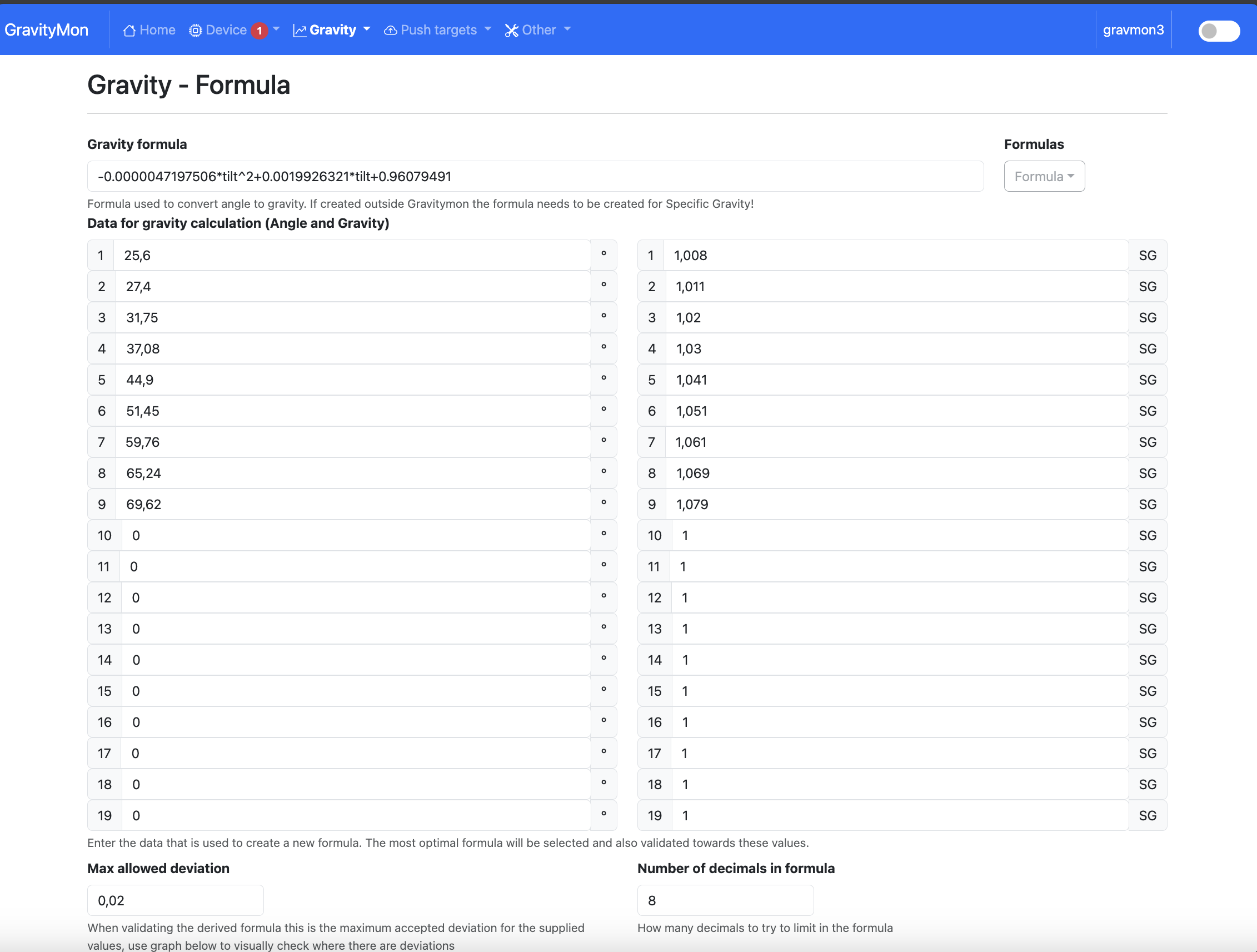
Gravity formula:
Gravity formula is syntax is the same as in the iSpindle, but the formula needs to be in SG since this is the internal format used. When choosing plato the SG value will be converted and presented as Plato. On this page to create the formula by supplying the raw data. If you use the internal formula creator then you can enter data in plato and conversion will be handled in the device, the output formula will always be in SG.
The gravity formula accepts two parameters, tilt for the angle or temp for temperature (temperature inserted into the formula will be in celsius). I would recommend to use the formula calculation feature instead since this is much easier.
Data for gravity calculation:
Enter your gravity data SG + Angle. You can enter up to 20 datapoints. Order does not matter and values with zero as angle will be ignored.
Max allowed deviation:
This is the maximum deviation on the formula allowed for it to be accepted. Once the formula has been derived it will be validated against the supplied data and of the deviation on any point is bigger the formula will be rejected. Example for SG can be 0.02 points or 0.5 for Plato. Setting a higher values will allow you to see more options.
Calculate formula:
When you submit the values the device will create formulas for order 1 to 4 and show those that are within the accepted deviation. You can also see how the formula performs in relation to your datapoints and what the deviation is per angle. The more data points you have the better the graph.
Report calibration data:
Will send you formula and calibration data points to my collection server anonymously to help improve the formula creation in future releases.
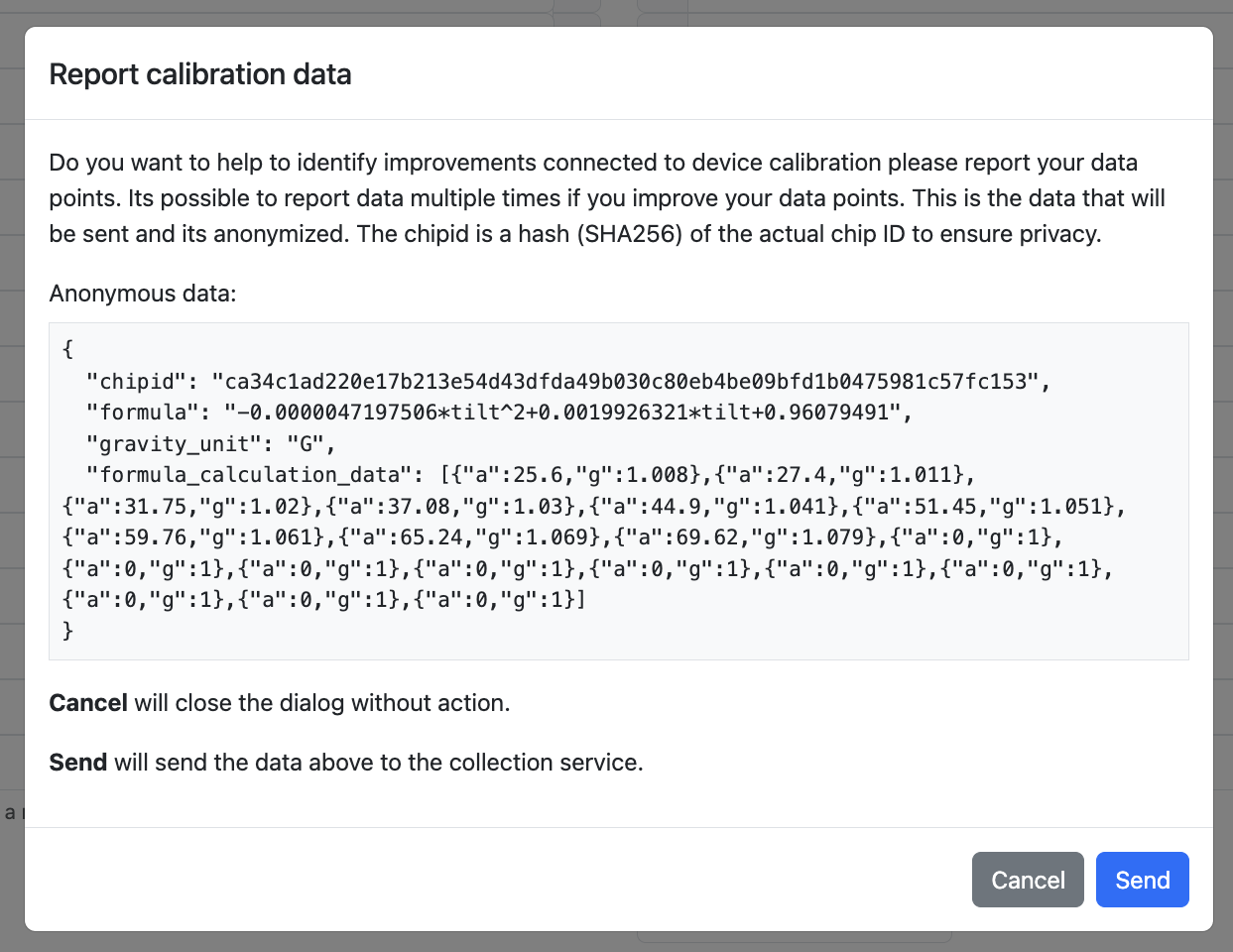
Here a graph is shown with your current formula compared with the entered data points.
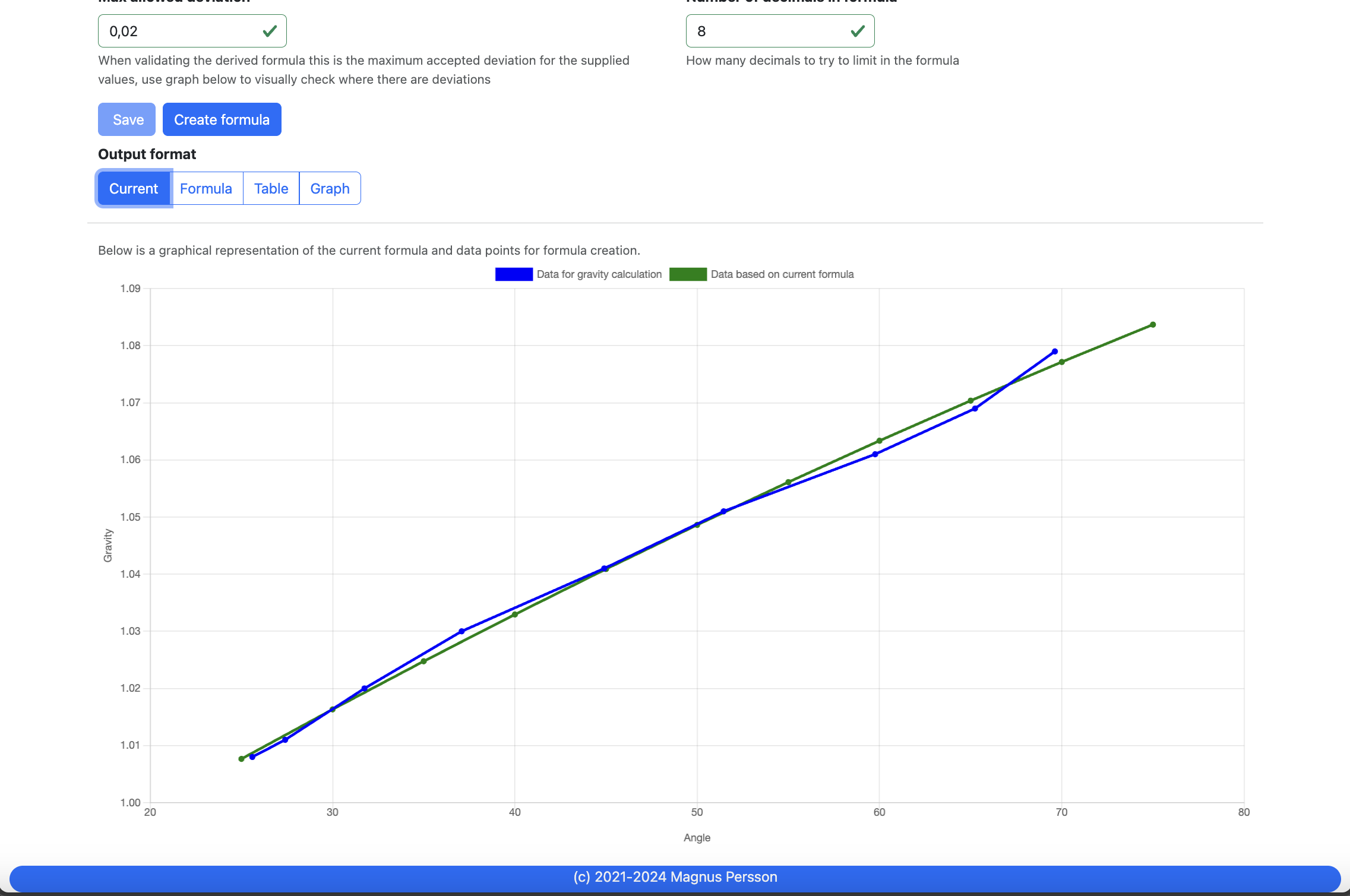
Here you can see the generated formulas. A drop down selector is available on the top to make it easy to select the formula you want.
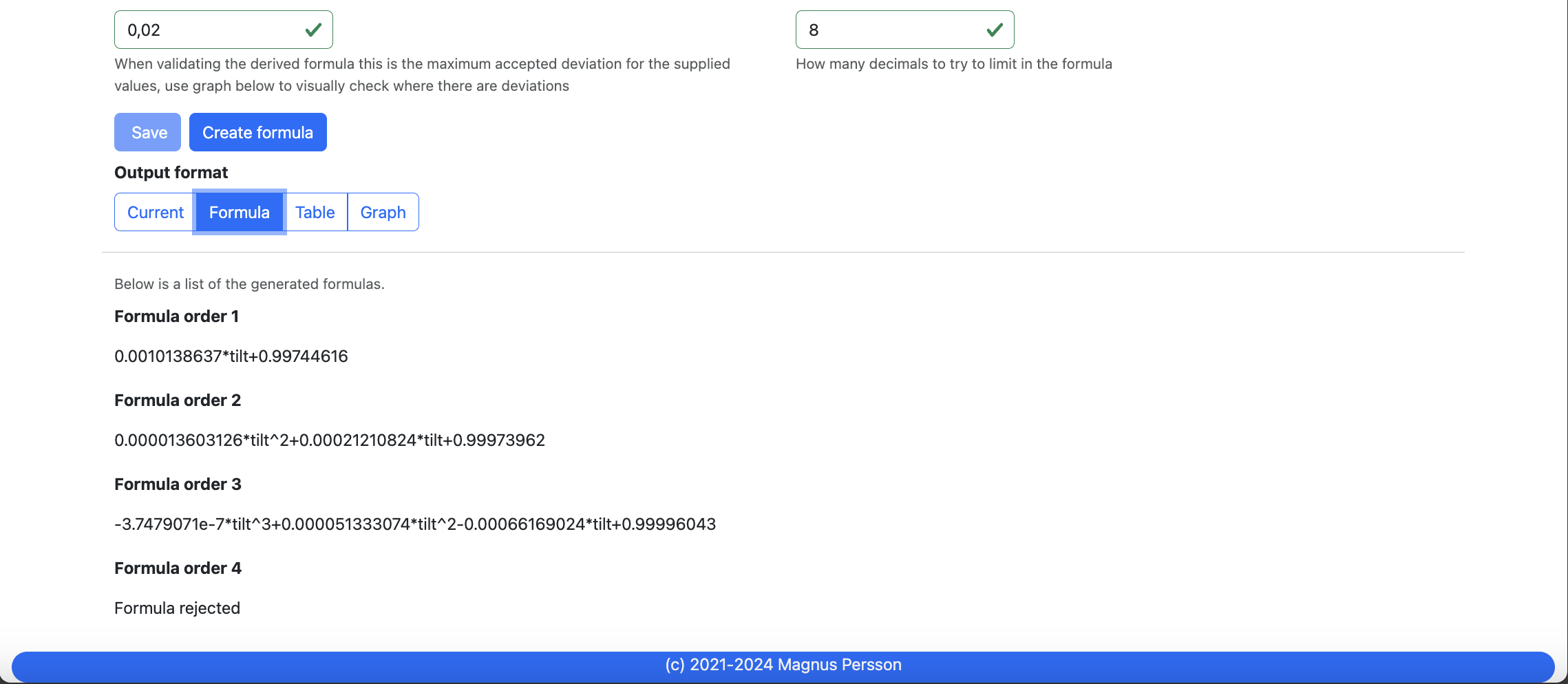
Table with calculated values per angle that has been used and the deviation from the entered data.
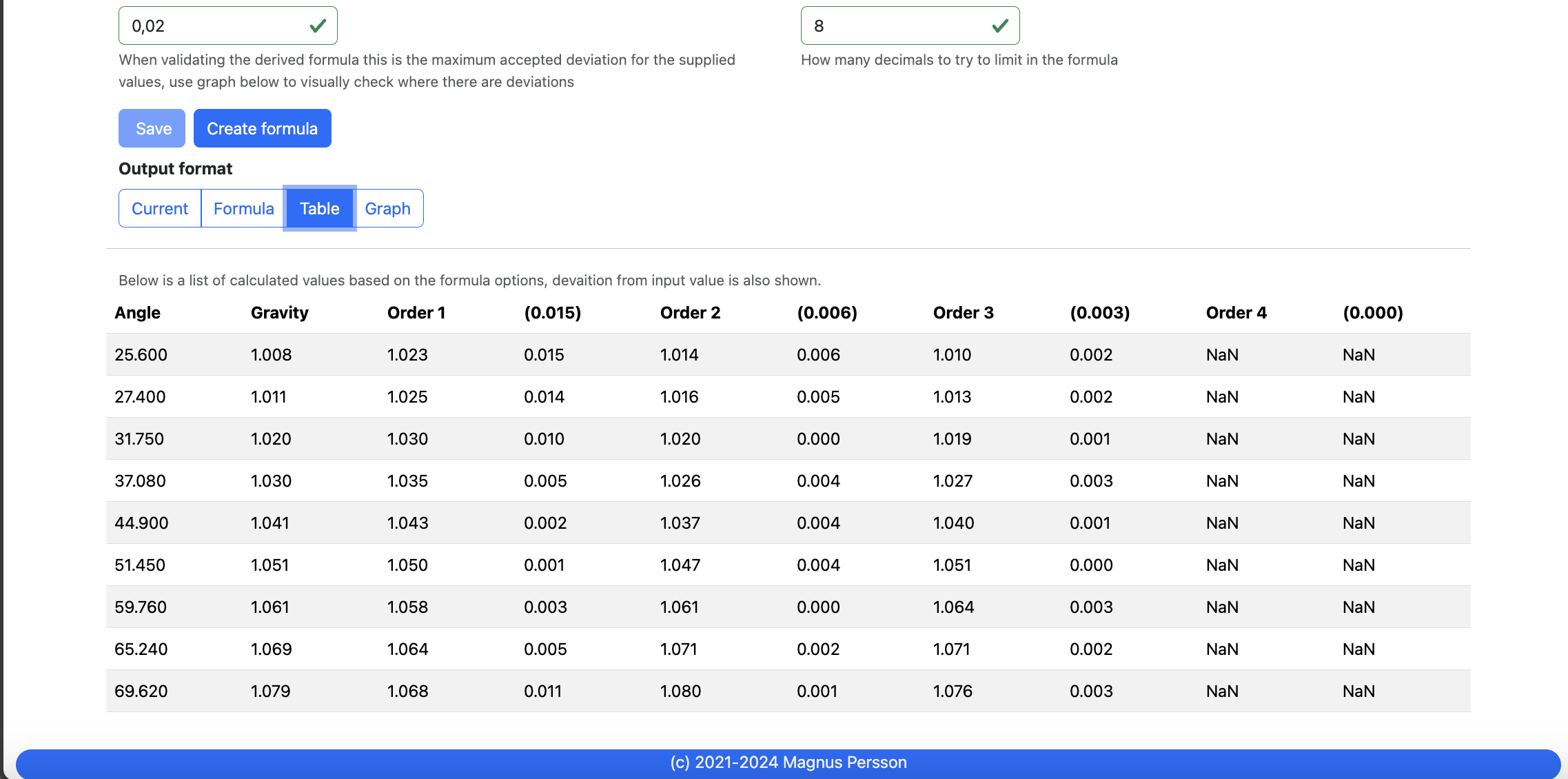
Here a graph is shown with the created formulas. You can deselect a formula by selecting the color in the legend.
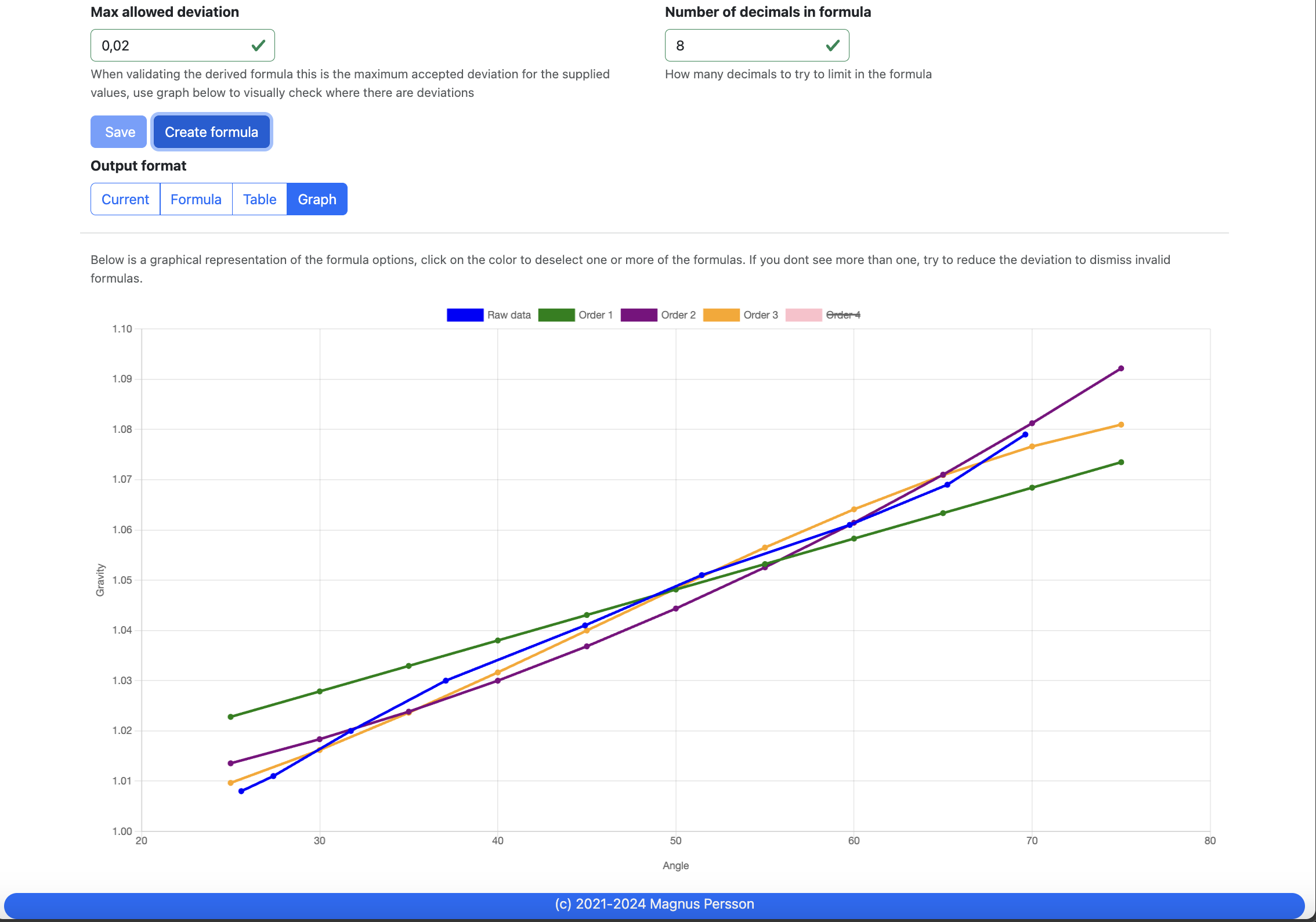
Push targets¶
Push - Settings¶
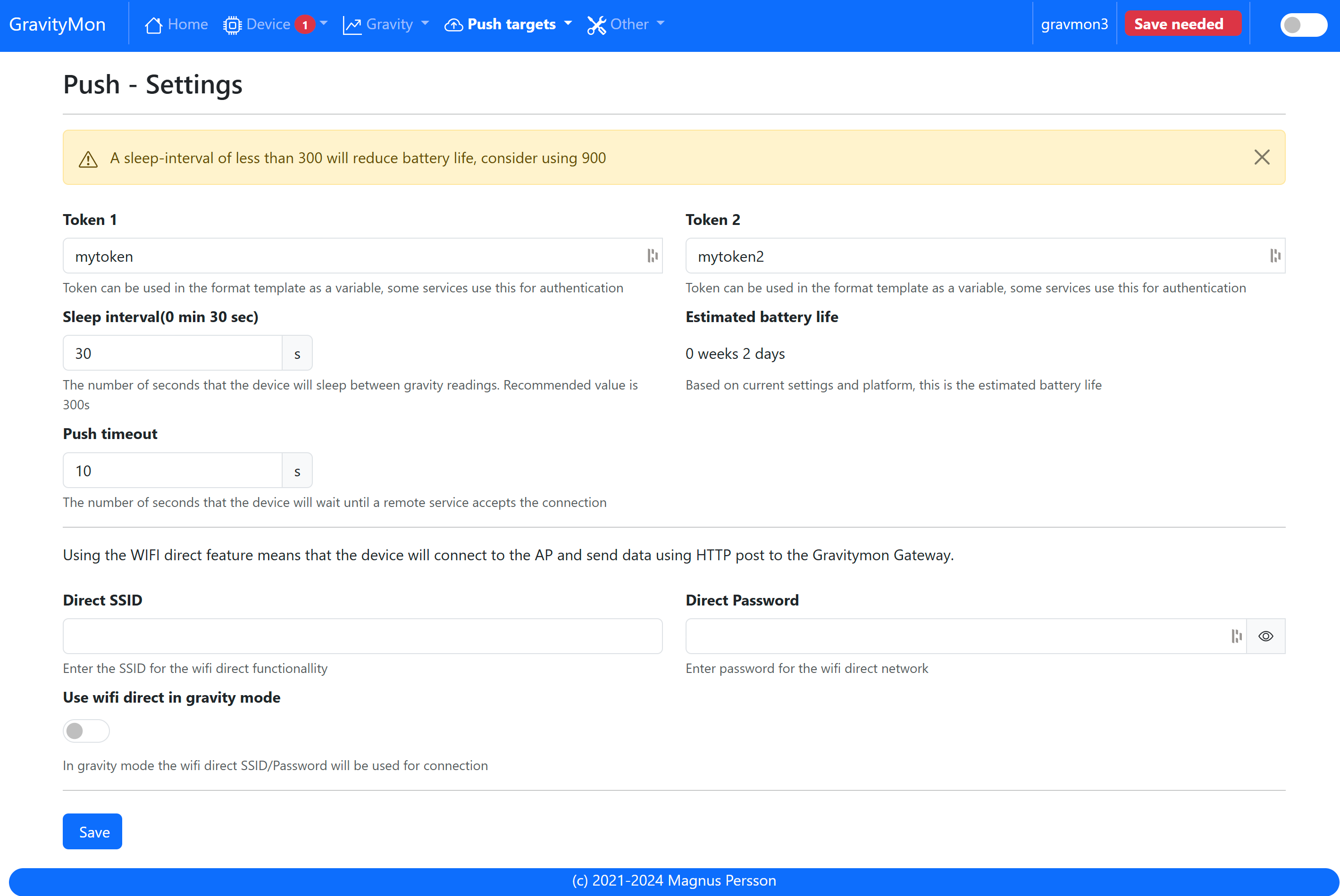
Token 1:
The token is included in the iSpindle JSON format and will be used for both HTTP targets. If you need to have 2 different tokens you can customize the data format.
Token 2:
The token is included in the default format for the HTTP GET url but can be used for any of the formats. For HTTP GET use can use this for an authorization token with ubidots api.
Sleep Interval:
This defines how long the device should be sleeping between the readings when in gravity monitoring mode. You will also see the values in minutes/seconds to easier set the interval. 900s is a recommended interval. The sleep interval can be set between 10 - 3600 seconds (60 minutes).
Note
A low value such as 30s will give a lifespan of 1-2 weeks and 300s (5 min) would last for 3+ weeks. This assumes that there is good wifi connection that takes less than 1s to reconnect. Poor wifi connection is the main reason for battery drain.
WIFI Direct SSID:
This WIFI SSID will be used during gravity mode to send data to the GravityMon Gateway.
Note
When WIFI Direct is enabled and the device can’t connect to the SSID then it will fallback to the standard SSID configured and try to send data that way using the defined push settings.
WIFI Direct Password:
This WIFI Password will be used during gravity mode to send data to the GravityMon Gateway.
Use WIFI Direct in gravity mode:
Enabling this feature will disable all other push target settings and data will be sent to the gateway in a pre-defined format (iSpindle format) when in gravity monitoring mode.
Estimated battery life:
Based on the hardware and the historical execution time the device will estimate how long it can run on a full battery with the current interval.
Push timeout:
How long the device will wait for a connection accept from the remote service.
Push - HTTP Post¶
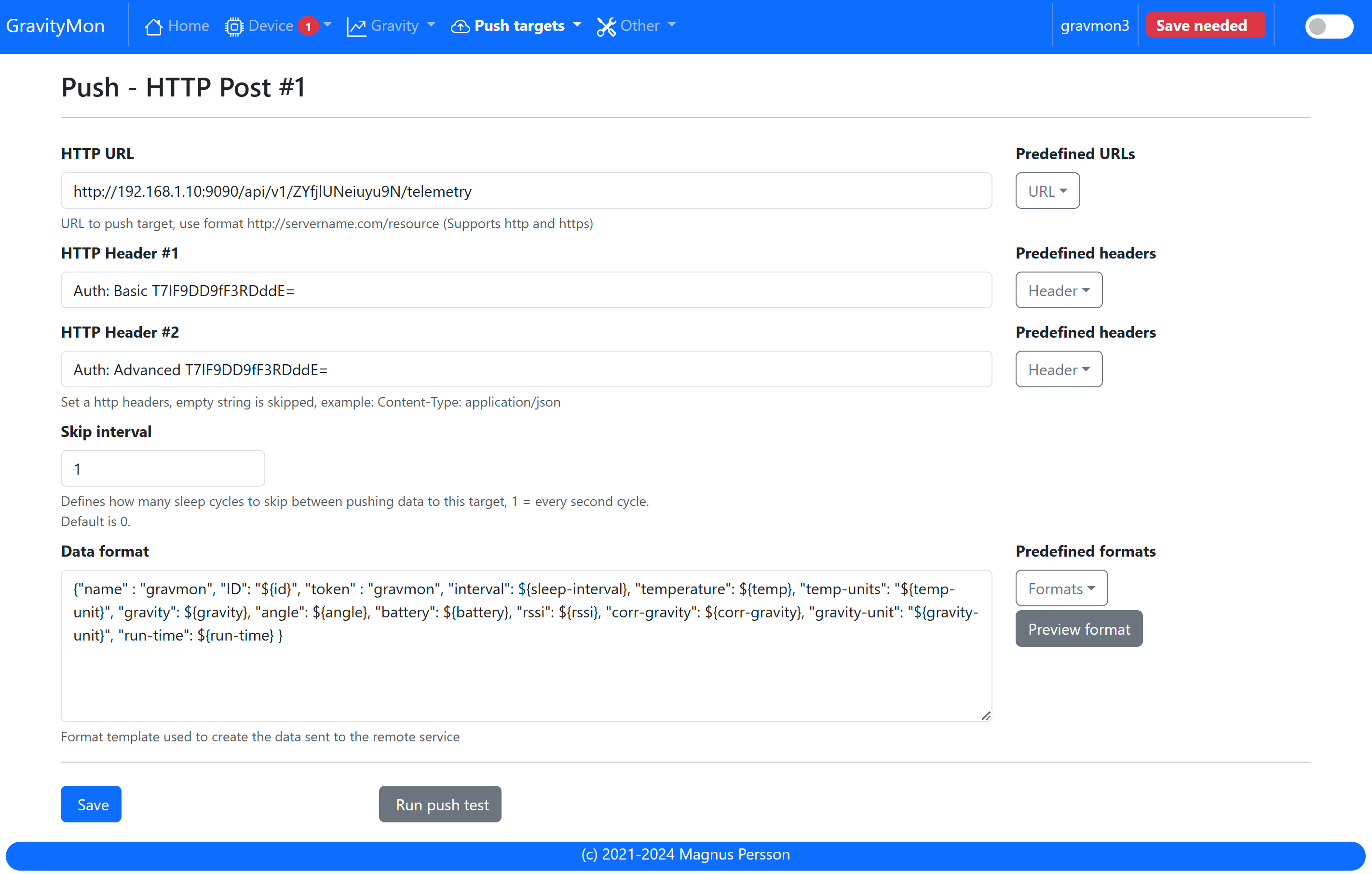
HTTP URL:
Endpoint to send data via http. Default format used is HTTP Post, iSpindle format. You can customize the format below.
If you add the prefix https:// then the device will use SSL when sending data.
Use TCP:
This setting skips using HTTP as the protocol and just send data through the connection. Added to support services that does not have a http server.
HTTP Headers
You can define 2 http headers. Enter a value or just select one from the list.
The input must have the format ‘<header>: <value>’ for it to work. The UI will accept any value so errors will not show until the device tries to push data.
Content-Type: application/json X-Auth-Token: <api-token>
Mozilla has a good guide on what headers are valid; HTTP Headers
Skip Interval:
These options allow the user to have variable push intervals for the different endpoints. 0 means that every wakeup will send data to that endpoint. If you enter another number then that defines how many sleep cycles will be skipped for this target.
Data format:
Here you can customize the data format used when sending data to the server. You can either enter your own formula or choose one from the list. For more information on this topic, see Format Templates.
Note
If you right click in this field a list of available variables will be shown.
Push - HTTP Get¶
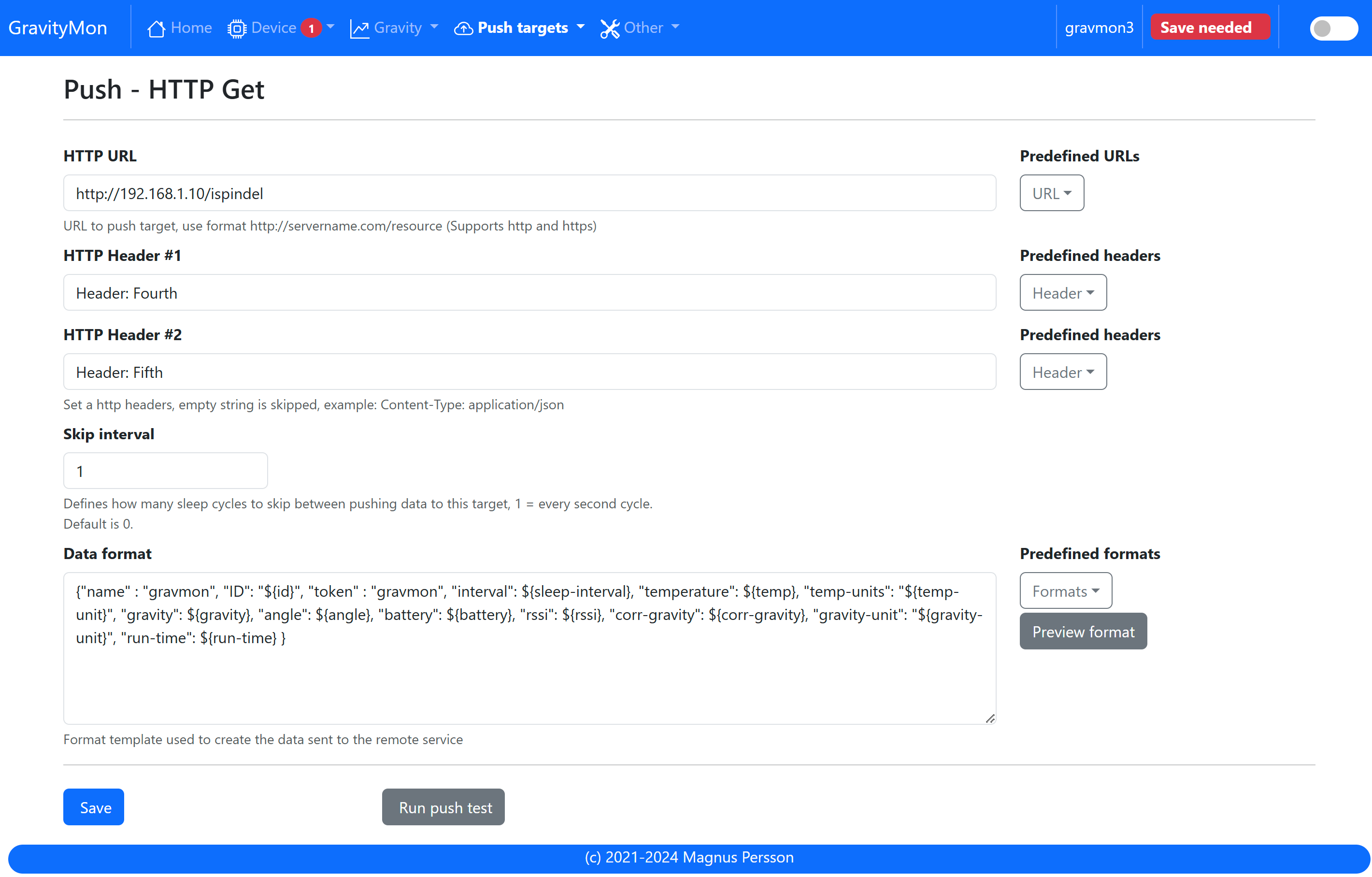
HTTP URL:
Endpoint to send data via http. You can customize the format below.
If you add the prefix https:// then the device will use SSL when sending data.
HTTP Headers
You can define 2 http headers. Enter a value or just select one from the list.
The input must have the format ‘<header>: <value>’ for it to work. The UI will accept any value so errors will not show until the device tries to push data.
Content-Type: application/json X-Auth-Token: <api-token>
Mozilla has a good guide on what headers are valid; HTTP Headers
Skip Interval:
These options allow the user to have variable push intervals for the different endpoints. 0 means that every wakeup will send data to that endpoint. If you enter another number then that defines how many sleep cycles will be skipped for this target.
Data format:
Here you can customize the data format used when sending data to the server. You can either enter your own formula or choose one from the list. For more information on this topic, see Format Templates.
Note
If you right click in this field a list of available variables will be shown.
Push - InfluxDB v2¶
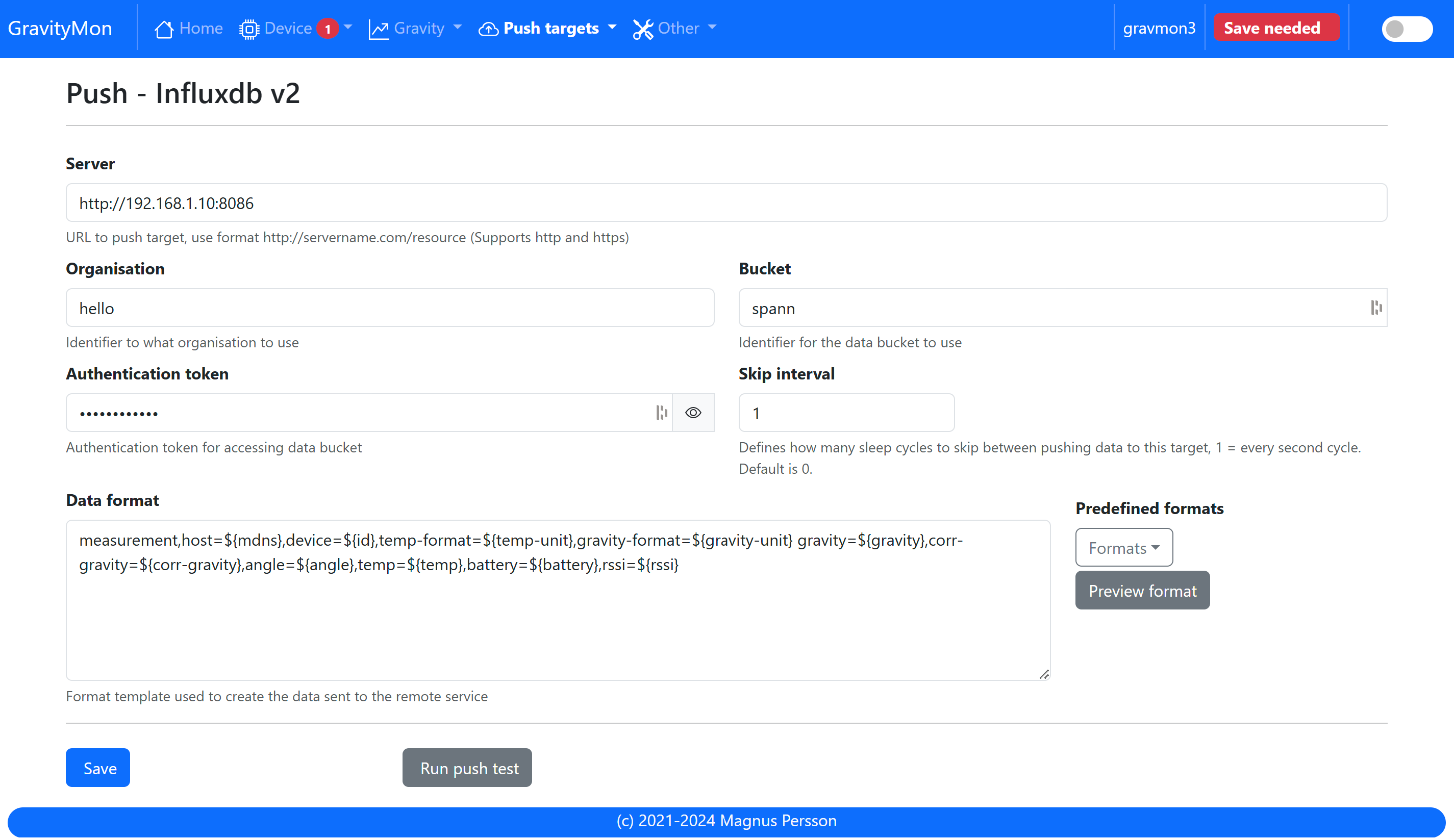
Server:
Endpoint to send data via http to InfluxDB. Format used HTTP Get. You can customize the format using Format Templates.
SSL is not supported for this target. Raise a issue on github if this is wanted.
Organisation:
Name of organisation in Influx.
Bucket:
Token for bucket. Don’t use the bucket name.
Authentication Token:
Token with write access to bucket.
Skip Interval:
These options allow the user to have variable push intervals for the different endpoints. 0 means that every wakeup will send data to that endpoint. If you enter another number then that defines how many sleep cycles will be skipped for this target.
Data format:
Here you can customize the data format used when sending data to the server. You can either enter your own formula or choose one from the list. For more information on this topic, see Format Templates.
Note
If you right click in this field a list of available variables will be shown.
Push - MQTT¶
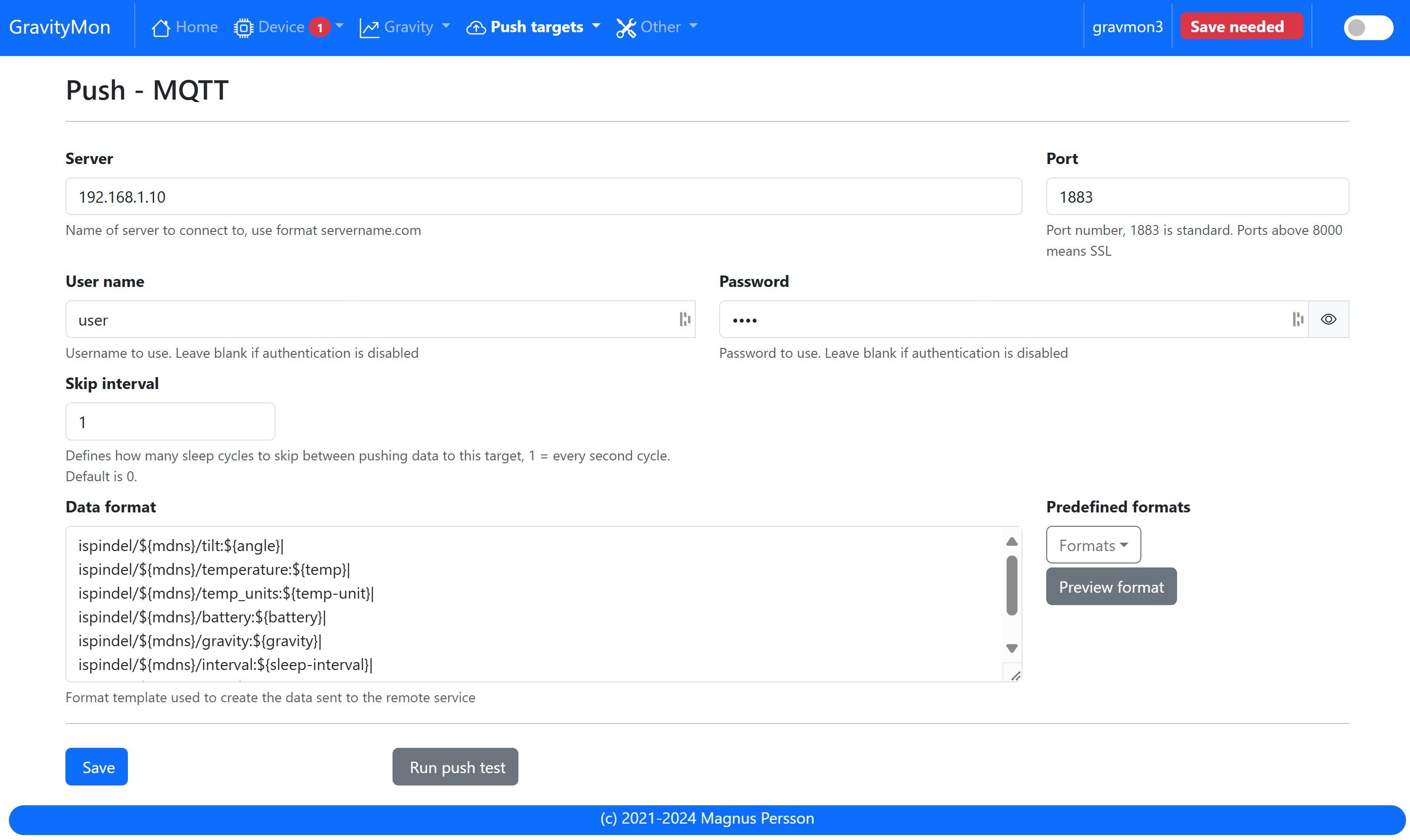
Server:
IP or name of server to send data to. Default format used MQTT. You can customize the format using Format Templates.
Port:
Which port should be used for communication, default is 1883 (standard port). For SSL use 8883 (any port over 8000 is treated as SSL).
User name:
Username or blank if anonymous is accepted
Password:
Password or blank if anonymous is accepted
Skip Interval:
These options allow the user to have variable push intervals for the different endpoints. 0 means that every wakeup will send data to that endpoint. If you enter another number then that defines how many sleep cycles will be skipped for this target.
Data format:
Here you can customize the data format used when sending data to the server. You can either enter your own formula or choose one from the list. For more information on this topic, see Format Templates.
Note
If you right click in this field a list of available variables will be shown.
Push - Bluetooth¶
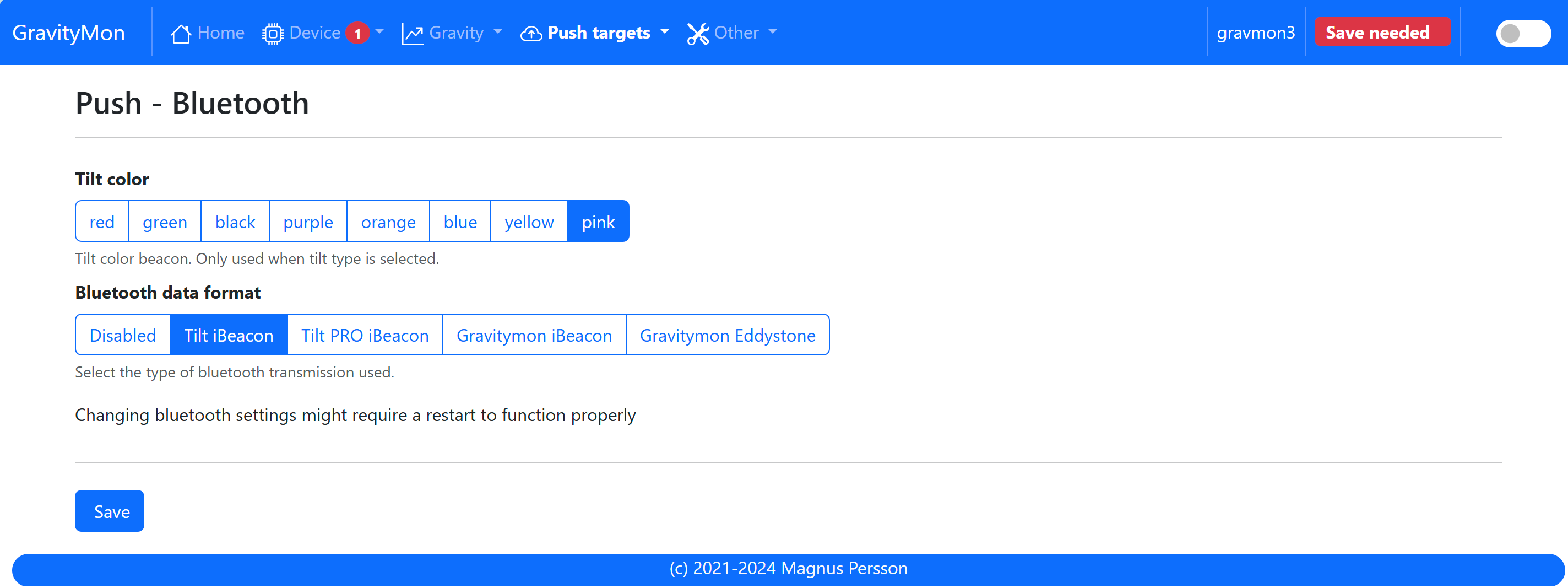
TILT color: (Only ESP32)
Select the TILT color that will be used to transmit data. Only valid if TILT format is chosen above.
Bluetooth data format: (Only ESP32)
Choose the bluetooth transmission to use.
TILT iBeacon: Standard tilt data transmission. Data: Gravity and Temperature
TILT PRO iBeacon: Higher accuracy tilt data transmission. Data: Gravity and Temperature
GM iBeacon: Higher accuracy. Data: Gravity, Temperature, ID, Angle
GM EDDYSTONE: Beacon format that requires active scanning by the client. Data: Gravity, ID, Temperature and Angle
RAPT v1: Beacon format used by the RAPT PILL.
RAPT v2: Beacon format used by the RAPT PILL.
Other¶
Other - Serial¶

Connects to the device and shows the serial output, useful for debugging.
Other - Backup¶
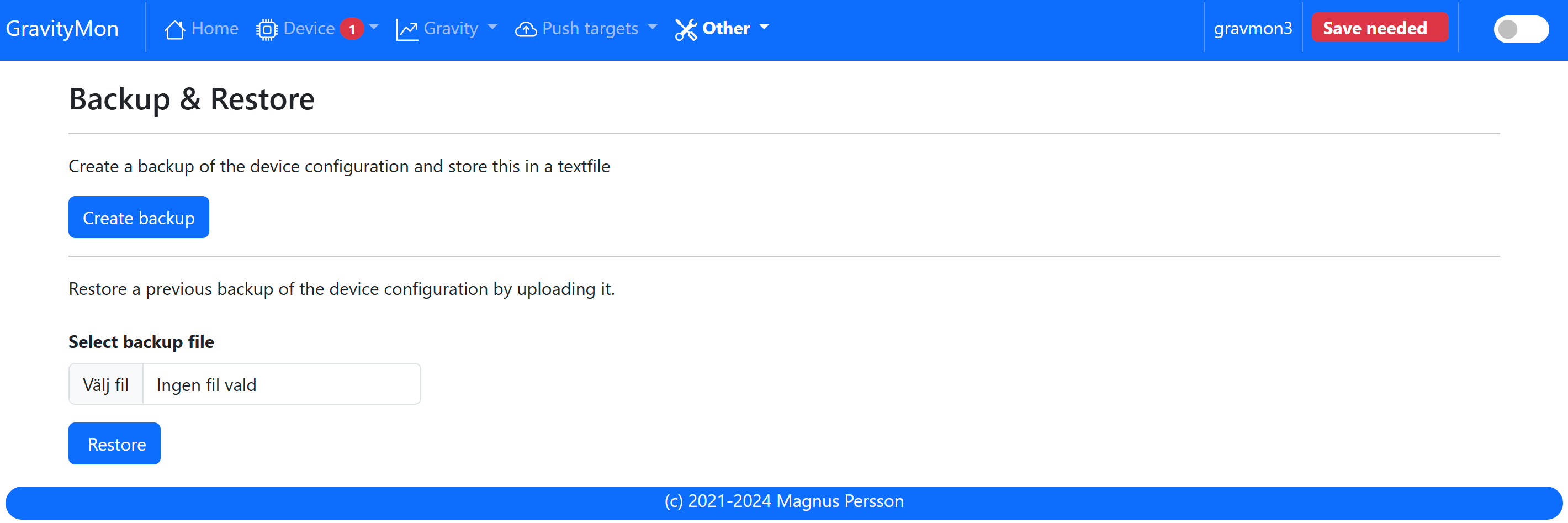
Here you can download a file with all of the device settings and also restore data if needed. Each file is unique for a device which is determined by the field “id”. Modifying this field will allow you to create a template that can be used on any device. This field is stored in more than one place of the file and all needs to be changed for this to work.
When downloading a backup the file will be named gravitymon<deviceid>.txt
Note
The gravity formula will be recreated if calibration points are available on the device, so the formula might be different than what is in the file.
Other - Firmware¶

Upload Firmware
This option gives you the possibility to install an new version of the firmware (or any firmware that uses the standard flash layout).
Other - Support¶

View device logs
Shows the log entires stored on the device, can also be used to delete the current logs.
Other - Tools¶
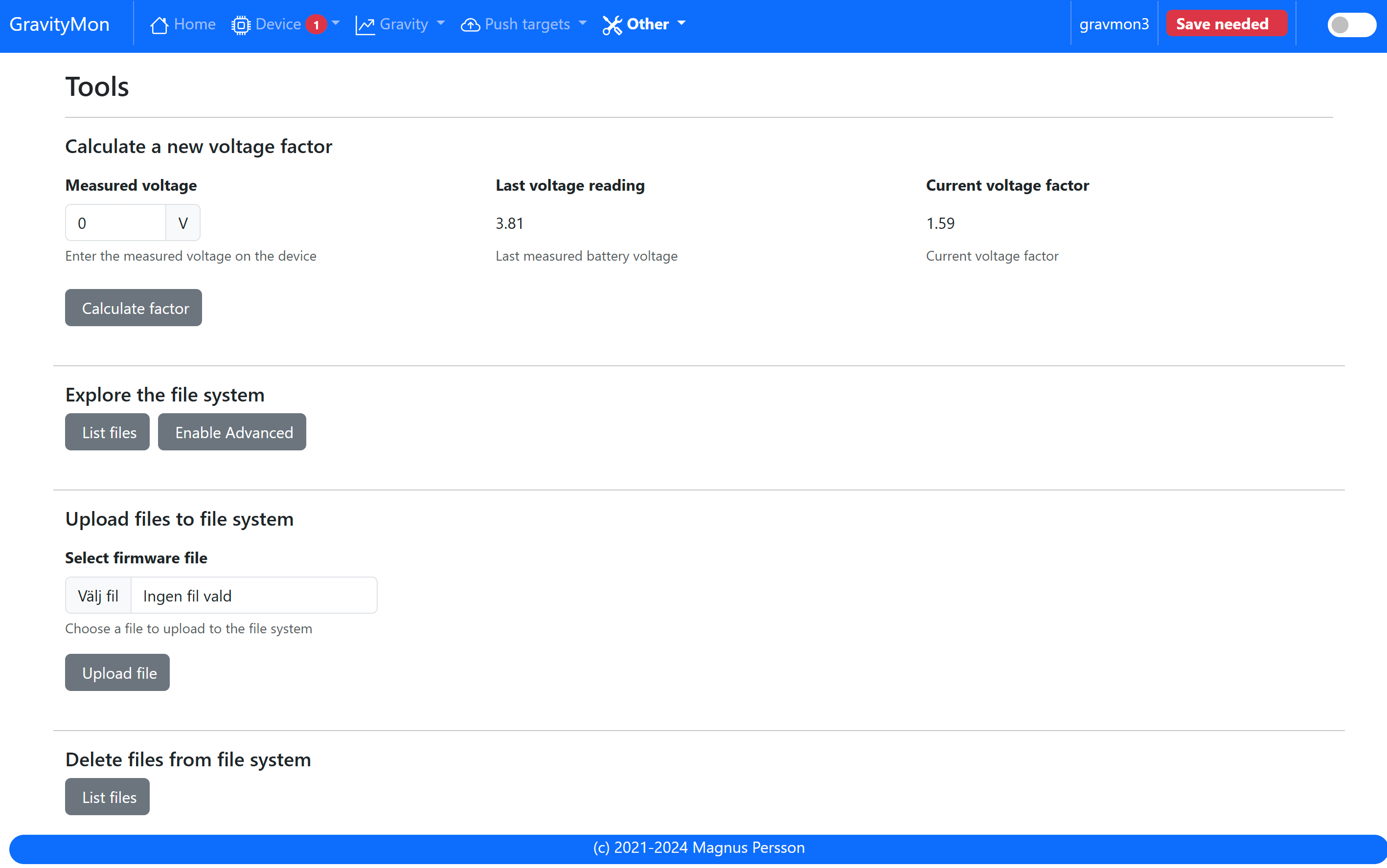
Calculate voltage factor
Can be used to calculate a new voltage factor based on measured voltage and current readings.
List files
Shows the files on the device and allows a user to show the contents of those files.
Other - About¶

Shows information about the software